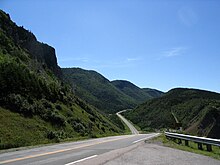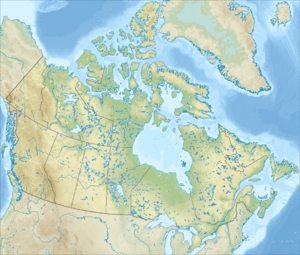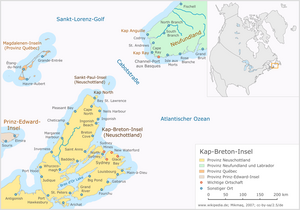Cape Breton Island
| Cape Breton Island | ||
|---|---|---|
| West coast of Cape Breton Island | ||
| Waters | Atlantic Ocean | |
| Geographical location | 46 ° 10 ′ N , 60 ° 45 ′ W | |
|
|
||
| length | 180 km | |
| width | 114 km | |
| surface | 10,311 km² | |
| Highest elevation |
White Hill 532 m |
|
| Residents | 147.454 (2001) 14 inhabitants / km² |
|
| main place | Sydney | |
| Map of the island | ||
The Cape Breton Island ( English Cape Breton Island , French île du Cap-Breton , Canadian Gaelic : Eilean Cheap Breatuinn , in the Indian language Mi'kmaq : U'namakika ) is an island in the North Atlantic . It lies on the North American shelf and belongs to the Canadian province of Nova Scotia . Cape Breton Island is separated from the mainland of New Scotland by the Canso Strait, which is only around 770 meters wide at its narrowest point , but is connected to it by a traffic dam that was built in 1955. At the end there is a bridge that connects Port Hawkesbury to the sea.
geography
The Cape Breton Island lies northeast of the mainland and borders with its north and west coast on the Saint Lawrence Gulf ; the west coast also forms the eastern border of the Northumberland Strait . The island is 10,311 km² and consists of a rocky coastline, hilly grassland, glacial valleys , mountains and plateaus. The landscape of the Cape Breton Island is dominated by the Bras d'Or lake system and the Cape Breton Highlands , the latter geologically an extension of the Appalachian Mountains . There are also Lake Ainslie , the Margaree River system, the Mira River and numerous small rivers and streams.
history

Archaeological excavations in Ingonish have uncovered a human presence dating back thousands of years, dating back to the Paleo-Indians (approx. 12,500 to 7,000 BCE) and the archaic maritime peoples (approx. 10,000 to 2,500 BCE).
Various sources suggest the first European contacts for the 1520s. Under French colonial rule, the Cape Breton island, originally inhabited by the Mi'kmaq tribe, was called Île Royale . The settlement by French colonists began in the 17th century. The capital was the fortress town of Louisbourg , conquered by the British troops under Jeffrey Amherst and James Wolfe in 1758 and dismantled in the following years , the reconstruction of which is one of the island's main attractions today. After the conquest, numerous British, especially Scottish, settlers came to Cape Breton Island. Above all, this includes around 50,000 Highland Scots who were driven or deported from their homeland due to the so-called Highland Clearances . Their descendants shape the island and its culture to this day. Their Celtic language was the most important colloquial language on the island for many decades, but today it is almost completely extinct, apart from a few remains. However, a community college near the city of Ingonish on the Cabot Trail still teaches this language to this day. Other immigrants came from the USA ( loyalists expelled from there ), Ireland , Italy and Eastern Europe. The focus of the settlement was the most economically developed eastern part of the island around Sydney. Today, English is the most widely spoken language, but French, Gaelic and the Mi'kmaq language also live on.
traffic
Since 1955, Cape Breton Island has been linked to the mainland by the Canso Causeway , a dam. The main port is traditionally Sydney on the east coast. The large ferries from Newfoundland run North Sydney to further ports are in Point Edward and Port Hawkesbury . The island can be reached by rail via the Canso Causeway, the main roads being the Trans-Canada Highway and the Cabot Trail . Economically, the island lived for a long time from coal mining and steel production, but both industries are deprived. In the past decades, tourism and the music industry have become increasingly important.
Culture
- Alexander Graham Bell , the inventor of the telephone from Edinburgh (Scotland), has a museum built in the city of Baddeck , which gives very precise insights into his personal life and his numerous inventions. Bell spent much of his life in Baddeck and many of his inventions were made here. It is one of the most visited museums on the island.
- Interesting music developed on Cape Breton due to the various influences → Traditional music on Cape Breton
Web links
Individual evidence
- ↑ Ken Donovan: Precontact and Settlement: Ingonish and Northern Cape Breton From the Paleo Indians to the 18th century . The Nashwaak Review, St. Thomas University, Fredericton, vols. 22–23, (Spring-Summer 2009), 330–387, p. 331
- ↑ Ken Donovan: Precontact and Settlement: Ingonish and Northern Cape Breton From the Paleo Indians to the 18th century . The Nashwaak Review, St. Thomas University, Fredericton, vols. 22-23, (Spring-Summer 2009), 330-387, p. 337



